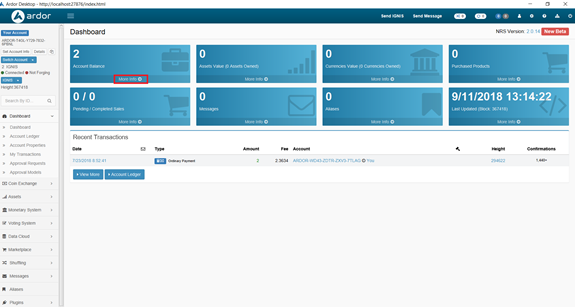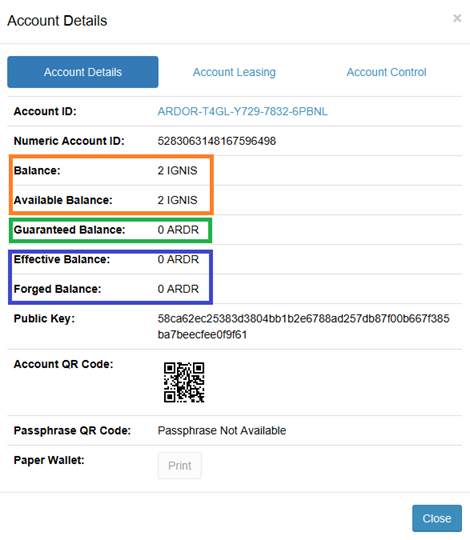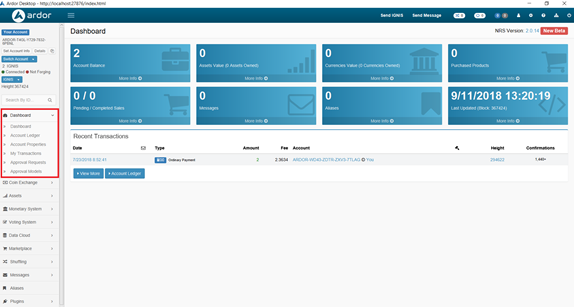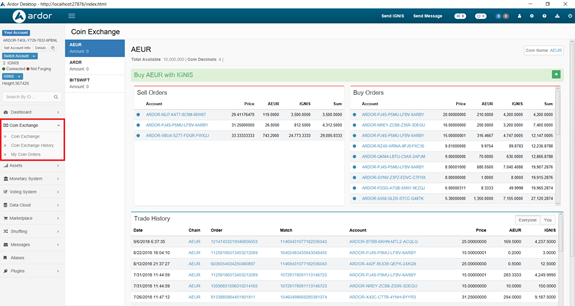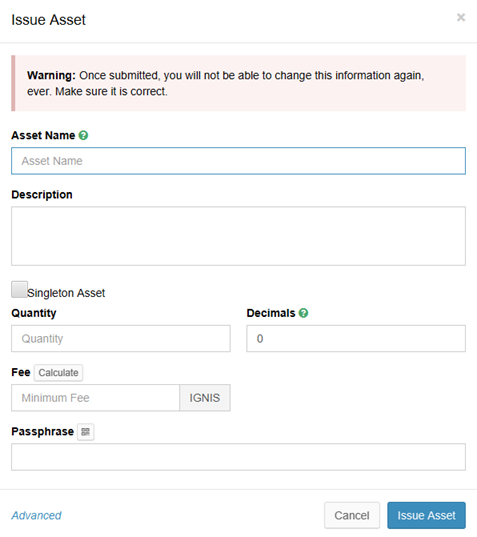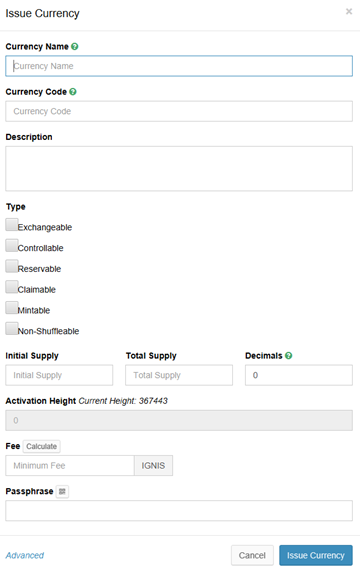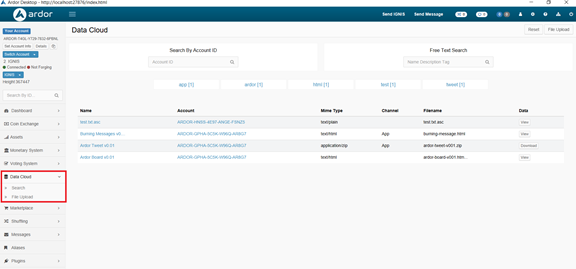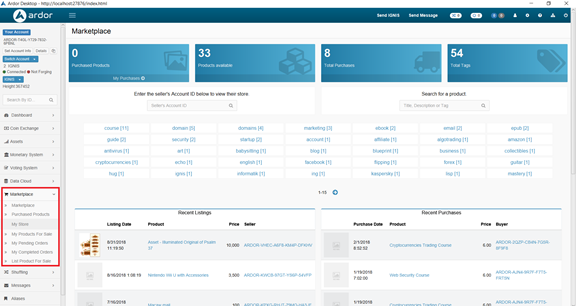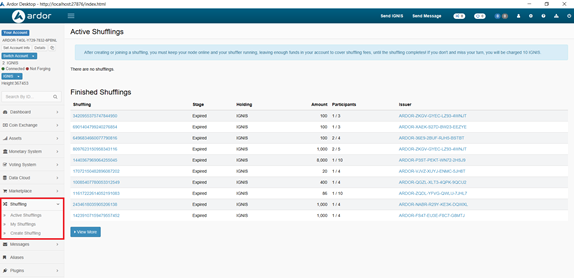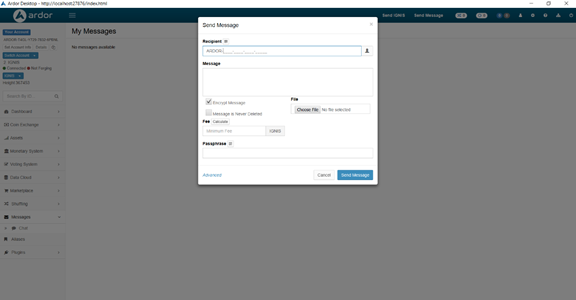Ignis child chains features
This guide provides an introductory tour of the live features available on the Ignis child chain as of August 2018. The information presented here represents a modified version of the information in the 11-minute long video Blockchain Ardor: Demo and Tour of Ardor and Ignis Features
The only prerequisite for joining this tour is that you must download the Ardor Client Wallet from the Jelurida website. An article explaining the download process is available here.
The Ignis Tour
Let’s begin the tour. Open your client wallet and log in to the Ignis chain.
Note: Since version 2.3.0e the login page has been redesigned, please refer to the Login Page Tutorial. This guide provides instructions for creating and accessing Ardor accounts through the Ardor Client Wallet.
The former login page was as follows:
Dashboard
We arrive on the Ignis Dashboard, which looks similar to the Ardor Dashboard but with 8 blue boxes. The options in the top toolbar remain mostly the same as explained in the Ardor guide, but with the addition of the send message option and information on shuffled (private) transactions.
In the center of the screen at the top row, the first blue box is our Ignis balance, the next is the quantity of assets owned on the Ignis chain, the 3rd box shows the quantity of any currencies owned, and the final box shows the number of items purchased through the marketplace. In the second line of boxes, we see the quantity of pending and completed sales through the marketplace. The second box shows how many messages you have. The third box shows the number of aliases you own. Aliases are like namespaces or domain names– they are shortened handles for referencing accounts. So, for example, you could purchase an alias so that clients, app users, or friends can send money to a name that is easier to remember than your current public address. The last box on this line shows the block information, just like the Ardor chain.
Understanding Ignis Account Balances
Click “More Info” on the Ignis Account balance.
A pop up box appears>
You’ll notice the Balance and Available balance (orange) reflect your Ignis holdings, however, your Guaranteed Balance (blue) refers to your actual Ardor balance, while your Effective and Forged Balances refer to the forging power of your Ardor coins, as explained in the forging features section. Note that there is an option for Account Leasing, but this does not work for Ignis. Forging power and the proof of stake consensus process are unique solely to the Ardor Parent Chain. The equivalent to forging for child chain transactions is a process called, “Bundling,” which you can refer to the bundling feature section.
Looking at the left side menu, we see our Dashboard with the same options as Ardor.
Decentralized Coin Exchange
There is also the decentralized coin exchange where you can purchase Ardor, GPS, or BITS using Ignis. Remember one of the key benefits of the Ardor ecosystem is the fact that the parent chain and all child chains are interoperable, which means new assets and tokens across child chains can seamlessly interact with one another.
The next two functions are some of Ignis’s most powerful: the issuance and exchange of assets and new monetary supplies.
Differences between Assets (green) and Monetary Supplies (blue)
Assets
On the Ignis child chain, you can issue and exchange singleton assets (individual assets) or a large supply of assets representing anything from equities to ICO tokens to sports or entertainment event tickets to real estate properties — you can even use assets to issue dividends.
The key here is that the name of an asset is not unique. The only way to identify a particular asset as legitimate is to verify its Asset ID, a series of randomly assigned numbers, against a list of Asset IDs known to be legitimate. You can use external tools such as https://ardor.tools and https://ardor.world as websites to research and identify assets before purchasing them in the wallet.
Monetary Supplies
Monetary supplies on the other hand, are like issuing your own cryptocurrency — the name is unique and the properties function a bit differently. Below, you see the list of existing monetary supplies.
There are a variety of options for issuing monetary supplies.
For example, given that the option for setting reserves exists. To learn more about the types of monetary supplies, check out this.
Voting System
The voting system is another element that can be useful in board rooms or municipal elections.
Polls are public but you can limit the participant pool based on various criteria, such as minimum account balance, or by requiring that participants hold a particular Asset.
This means you could issue an asset only to your intended users, set up a poll that only allows people holding that asset to vote, and then continue on with the voting, effectively limiting the participant pool while maintaining a public record of the vote.
Data Cloud
The data cloud allows you to upload files to the blockchain and receive a hashed version of the file as a sort of “proof of existence.”
The documents themselves are “pruned” or removed from the blockchain, leaving just the hash. This minimizes the blockchain size while allowing you to reference the hash on your document, against the remaining hash on the blockchain to prove authenticity at a later date. This could have major applications for the copyright industry, insurance industries, and for cloud services.
Marketplace
The marketplace is like a craigslist environment where you can purchase and sell all types of goods.
It was originally meant for digital goods, like software registration codes, but has grown to include some physical items. Note, due to the nature of immutability on the blockchain, fraudulent and inappropriate listings cannot be prevented. There is also currently no way to reverse a transaction if a seller fails to send a product to the buyer. It’s a rich functionality — but be careful when dealing with this decentralized application.
Shuffling
Shuffling is synonymous with private transactions. It’s pretty straightforward, but could have big implications when it comes to combining this with other features, such as voting to protect identities.
Messaging
Secure and arbitrary messaging are both pretty straightforward on the surface, but the potential goes beyond what we see here. There have been suggestions to use this feature to create decentralized applications, or a more complex distributed data storage system. You can get creative sending JSON files across the blockchain.
Aliases
Aliases — this is where you can purchase your shortened account name to make it easier for app users or friends to send you or your business funds in Ignis ecosystem. You can also buy up aliases on a child chain that you think businesses might want in the future.
Continue with bundlers and transaction vouchers
Learn how businesses and developers launching tokens on existing child chains, or businesses launching their own child chains, can provide free transactions and custom tiered fee structures to their end-users by learning about transaction “Bundlers” tutorial.
You also have the option of learning more about the revolutionary features of the Ardor ecosystem, such as Transaction Vouchers, which make it easy to send dual signature invoices and share distributions on the blockchain. They also make it possible to create counterfeit-proof “deposit” and “withdrawal” vouchers.
Turing-complete lightweight contracts represent the next generation in smart contract technology and it’s a feature exclusive to the Ardor ecosystem. Written guidance on lightweight contracts is available here and you can refer to several articles describing the functionality [1]




